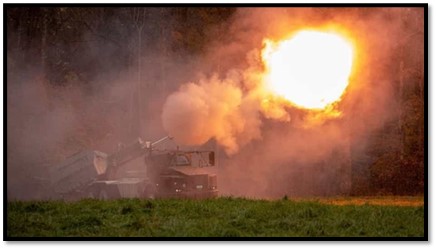By: Warren Gray
Copyright © 2023
“A single gun hitting a single target with several shells at the same time.
Because it can set up in 30 seconds, shoot a shell every five seconds for
15 seconds, then prepare for movement in another 30 seconds, an Archer
crew can send a salvo toward an enemy position as far as 25 miles away,
and be on the move before all three rounds explode at the same instant.”
— David Axe, for Forbes magazine, January 20, 2023.
On Thursday, January 19, 2023, the Swedish government officially announced that it would soon donate an unspecified number (probably 12) of advanced, Bofors FH77BW L52 Archer self-propelled, 155mm artillery systems to Ukraine. They stated that “Archer is an artillery system that can be moved quickly on wheels, fired quickly, and has great accuracy. It has long been on Ukraine’s wish list.”
The Swedish army already possesses 48 Archer guns, costing $4.5 million each, and has ordered a further 24 units from the manufacturer. Mounted upon a modified, 30-ton, 340-horsepower, Volvo A30D 6×6 articulated, all-terrain vehicle is a fully-automated, FH77 L52 155mm howitzer. The big gun carries 21 projectiles in a fully-automatic magazine, which can be reloaded in just 10 minutes.
Using BAE Bofors/Nexter Bonus rounds, the weapon’s effective range is 22 miles, but due to the glide wings of the precision-guided, Raytheon/Bofors M982 Excalibur rounds, the range of the gun is extended to 35 miles or more. The Excalibur shells are GPS guided and accurate to within 13 feet at any range. Ukraine has already been utilizing M982 rounds in other artillery systems, so no extra training is required.

United States Army, Public domain, via Wikimedia Commons
The Archer system can be set up and deployed in less than 30 seconds, normally firing at a continuous rate of one round every 48 seconds, an intensive rate of one round every 7.5 seconds, or a salvo rate of three rounds in 15 seconds. This provides multiple-round, simultaneous-impact (MRSI) capability, which means that several shells are fired in succession with different trajectories, so they hit the target simultaneously. After firing, the system can relocate within 30 seconds at speeds of up to 56 miles per hour, even traversing snow up to three feet deep, thus enabling it to “shoot-and-scoot” while its deadly projectiles are still in the air, and before Russian forces can return fire.
However, in the unlikely event of being caught a little too close to the front lines, or dodging an incoming artillery barrage, the Archer’s four-man crew cab is armored with bulletproof doors and windows. A Kongsberg (Norwegian) M151 Protector remote weapon system (RWS) overhead defends the vehicle with a remote-controlled, .50-caliber, M2HB heavy machine gun. And finally, the howitzer barrel may be depressed to minus one degree from the horizontal plane in order to engage ground targets, such as enemy tanks, with direct sighting out to 2,200 yards.

Stridsvagn122, CC BY-SA 4.0, via Wikimedia Commons

Ibaril, CC BY-SA 3.0, via Wikimedia Commons
Here’s how it would play out in an actual, combat scenario: Let’s say that the front lines are established at Severodonetsk, and there’s an independent Archer vehicle operating near Zakitne, 22 miles farther west. A platoon of six advanced, Russian T-90M “Vladimir” (named for its designer, Vladimir Potkin, not President Vladimir Putin) tanks, including a T-90MK command vehicle (or even brand-new, T14 Armata tanks), roll to a halt near Severodonetsk and are captured on video by an orbiting, Ukrainian Bayraktar TB2 (Turkish-made) drone. The drone precisely records the GPS coordinates of all six, stopped Russian tanks, and electronically relays that data to the roving Archer artillery system.
The Archer’s artillery operator then loads all six coordinates into his fire-control computer, and the vehicle briefly stops to fire two separate, 15-second salvos, totaling six M982 Excalibur rounds in the air at the same time, all on different trajectories and set to impact simultaneously. From the firing of the first round, until the Archer vehicle relocates at high speed, the elapsed time is exactly one minute, not nearly enough for Russian artillery forces to locate the Ukrainian firing position in time, even with ballistic computers.

Bryan Myhr, Public domain, via Wikimedia Commons
Next, the six Excalibur rounds strike the deployed, T-90M tanks at the same time, unseen and unheard until it’s too late, with a 92-percent probability of a direct hit, wiping out the new Russian tanks all at once, with no warning whatsoever. And, even if Russian drones manage to locate the original firing position of the Ukrainian Archer vehicle, it’s long gone by the time they are able to react and return fire. That’s the beauty of the Bofors Archer system, its speed, accuracy, mobility, and versatility on the battlefield, unmatched by anything that the Russians can muster to counter it.
So, it’s hardly surprising that the U.S. Army has expressed an interest in acquiring the Archer artillery system, which was demonstrated at Camp Atterbury, Indiana, on November 15, 2021, and the Swiss armed forces are also quite impressed with the Archer’s unique capabilities. It’s fast, accurate, highly mobile, and undetectable!
* * *
Warren Gray is a retired, U.S. Air Force intelligence officer with experience in joint special operations and counterterrorism. He served in Europe (including Eastern Europe) and the Middle East, earned Air Force and Navy parachutist wings, four college degrees, and was a distinguished graduate of the Air Force Intelligence Operations Specialist Course, and the USAF Combat Targeting School. He is currently a published author, historian, and hunter. You may visit his website at: warrengray54.vistaprintdigital.com.

